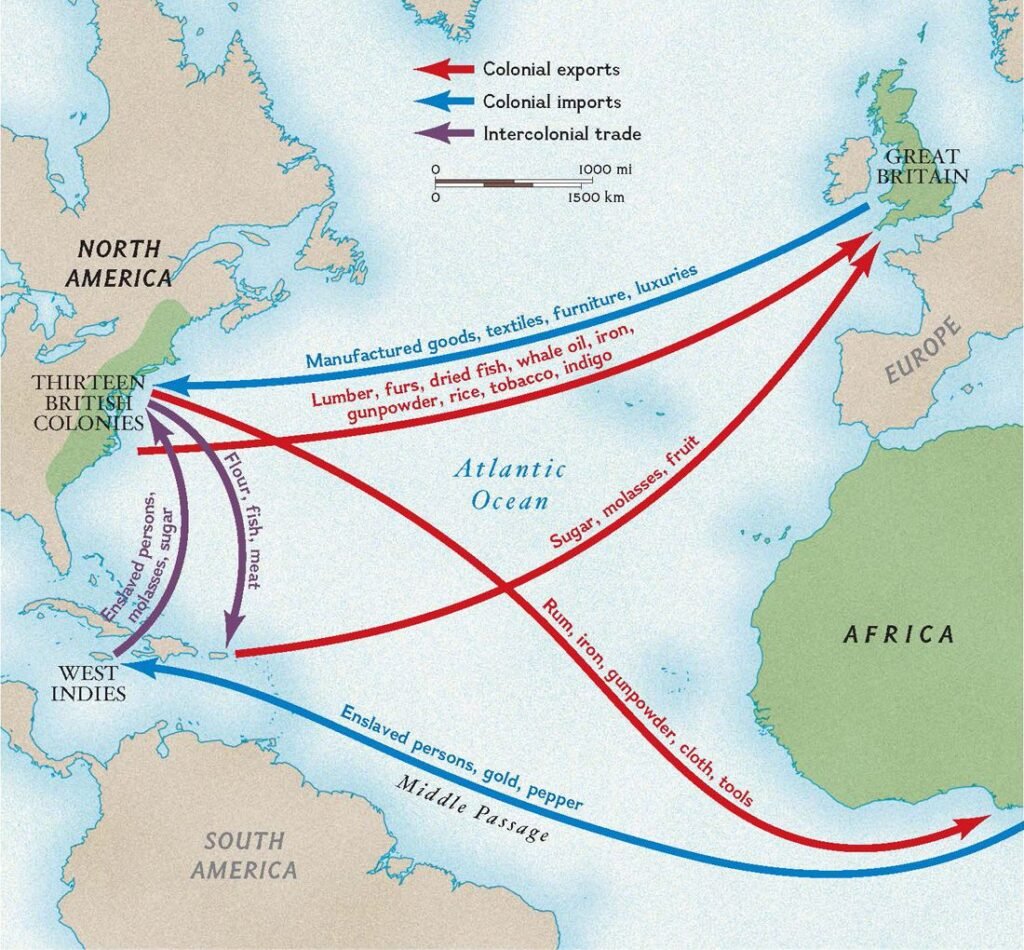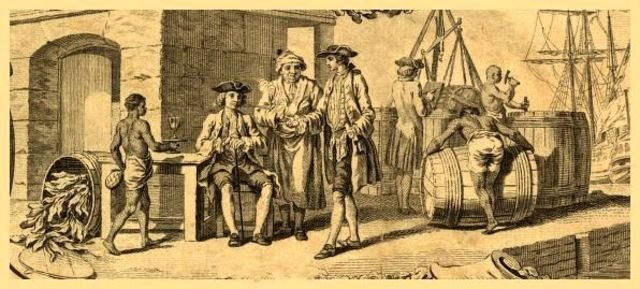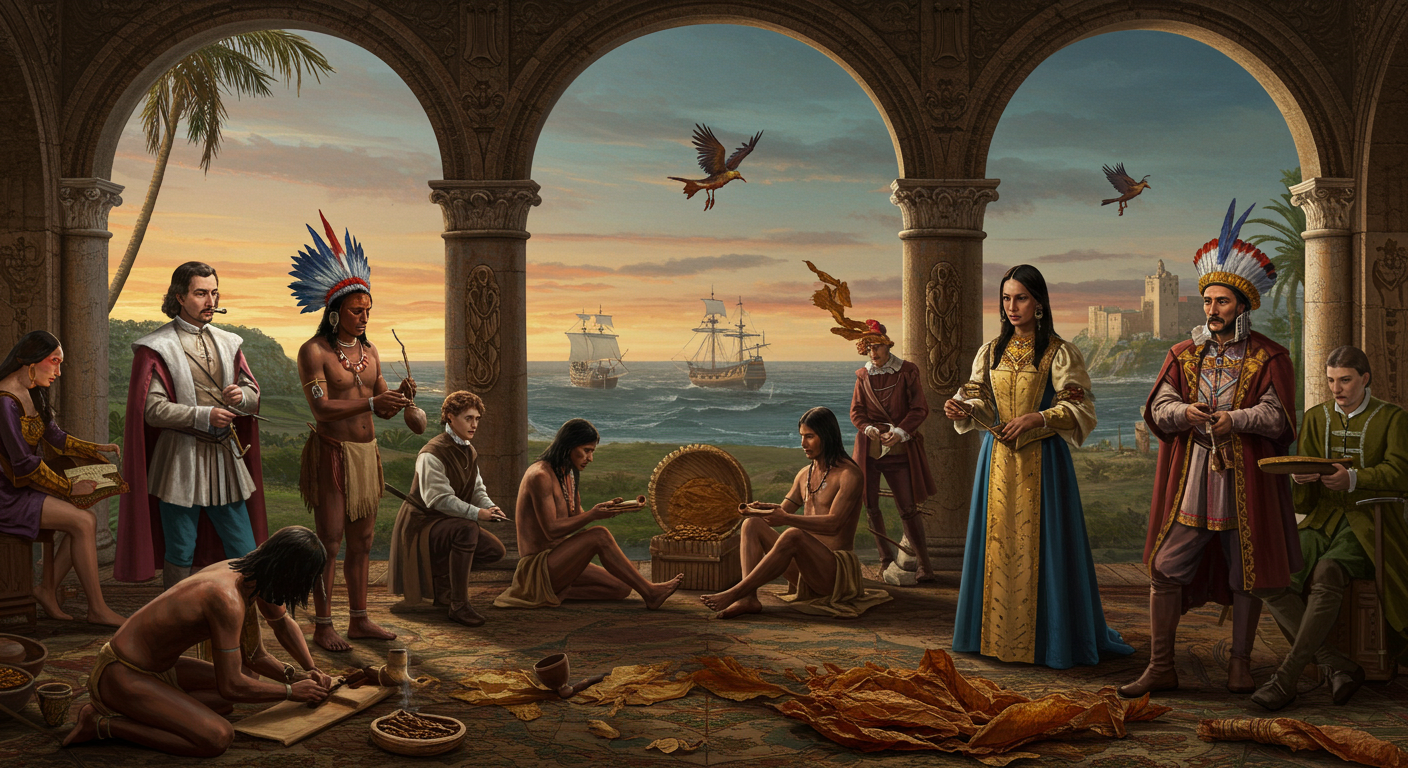When was tobacco introduced to Europe? Tobacco made its European debut in the late 15th century, thanks to Christopher Columbus and his crew. Before its introduction to Europe, indigenous peoples of the Americas had been using tobacco for centuries, primarily for ceremonial and medicinal purposes. They observed indigenous peoples using tobacco in the Americas, which sparked interest back home. This newfound interest would soon lead to significant changes in European customs and trade practices.
The arrival of tobacco in Europe initiated a transformative cultural evolution. Initially, tobacco gained popularity among the elite, who viewed it as a fashionable commodity. This trend led to its rapid acceptance and integration into European society, influencing social customs and trade practices. The cultural implications of this integration were profound and far-reaching.
As I have shown, figures like Jean Nicot played a crucial role in popularizing tobacco. His efforts led to the cultivation of tobacco as a cash crop, establishing a thriving tobacco culture. This culture significantly impacted European trade, creating new economic opportunities and altering social dynamics.
Emphatically, the introduction of tobacco to Europe not only altered social dynamics but also created new economic opportunities. By the 17th century, tobacco became a staple among the elite; however, by the 19th and 20th centuries, health debates emerged. These discussions prompted regulations that transformed tobacco’s role in society, highlighting the evolving perceptions of smoking and its health implications.
The Shocking Truth About When Tobacco Was Introduced to Europe and Its Impact on Society
Tobacco, introduced to Europe in the late 15th century, was used by indigenous peoples of the Americas for centuries before Columbus’s voyages. Columbus and his crew observed the Taíno people in the Caribbean using tobacco, smoking it in pipes and rolling it in leaves, which sparked their interest in this new substance. This encounter marked the beginning of a significant cultural exchange between the Old World and the New World.
In 1492, tobacco made its way to Europe, marking a pivotal moment in the history of smoking in Europe. The initial introduction of tobacco occurred when Columbus returned from his voyages to the Americas. He brought back not only tobacco but also the knowledge of its use among the indigenous peoples, who had cultivated it for generations. This knowledge would play a crucial role in shaping European attitudes towards tobacco consumption.
The Taíno people, among others, rolled tobacco in leaves and smoked it, creating a unique cultural practice. This practice fascinated European elites, who quickly adopted tobacco as a fashionable commodity. As a result, tobacco’s arrival in Europe reshaped social interactions and opened up fresh economic avenues.
Notably, the timeline of tobacco’s acceptance in Europe illustrates its swift assimilation into cultural practices. By the 17th century, tobacco had become a staple among the upper classes, influencing various aspects of life. Nevertheless, by the 19th and 20th centuries, health debates emerged, prompting regulations that changed its role in society.
In truth, the history of smoking in Europe reflects the profound impact of tobacco. This cultural shift highlights the profound influence of tobacco on European society and its evolving perceptions over time.
How The Introduction Of Tobacco To Europe Sparked Elite Obsession
The introduction of tobacco to Europe by Columbus marked the beginning of its rapid rise in popularity among the European elite. This event transformed social customs and trade practices across the continent. The implications of this transformation were felt in various aspects of daily life and social interaction. Tobacco quickly became a fashionable commodity, captivating the interest of many.
The first recorded instance of tobacco being brought back to Europe was by Columbus himself, who returned with tobacco seeds and leaves. This marked a pivotal moment in the history of smoking in Europe. As long as tobacco gained traction, it became a symbol of status among the elite. This status symbol further fueled the demand for tobacco across different social classes.
When tobacco first arrived, it was primarily used in ceremonial contexts by indigenous peoples. The Taíno people, for instance, rolled tobacco in leaves and smoked it, showcasing its cultural significance. Once Columbus introduced tobacco to Europe, it quickly transitioned from a native practice to a European trend. This shift significantly influenced the history of tobacco in Europe, as it became integrated into daily life.
The introduction of tobacco to Europe not only altered social dynamics but also created new economic opportunities. In general, the cultivation of tobacco not only created new economic opportunities but also shaped social dynamics. With the result that, tobacco’s influence extended beyond mere consumption, shaping the very fabric of European society.
Overall, the history of smoking in Europe reflects the profound impact of tobacco. The rapid rise in popularity among the elite marked a new era in social customs. As tobacco became a staple, it also prompted discussions about health and regulation, highlighting its evolving role in society.

When Was Tobacco Introduced to Europe and How It Changed Society Forever
The introduction and popularization of tobacco in Europe can be traced back to Christopher Columbus and later figures like Jean Nicot, who significantly influenced its acceptance and use in society. Columbus’s voyages in the late 15th century marked the beginning of European interest in tobacco. His crew observed indigenous peoples using tobacco for various ceremonial and medicinal purposes. This interest would soon evolve into a widespread cultural phenomenon across Europe.
Following Columbus’s initial encounter, other explorers and traders played crucial roles in the spread of tobacco. Jean Nicot, a French diplomat, introduced tobacco to the French court in the 1560s. His promotion of tobacco led to its association with sophistication and social status, further embedding it into European culture.
The history of smoking in Europe reflects a complex evolution influenced by various cultural exchanges. To put it another way, the history of smoking in Europe reflects a complex evolution influenced by various cultural exchanges. Initially, tobacco was a novelty, captivating the elite who sought to emulate indigenous practices. This fascination quickly transformed tobacco into a fashionable commodity, altering social customs across the continent.
As tobacco gained popularity, it became a significant cash crop. For one thing, the cultivation of tobacco in European colonies significantly influenced trade and economic practices. The cultivation of tobacco not only created new economic opportunities but also shaped social dynamics. By the 17th century, tobacco had established itself as a staple among the upper classes, influencing various aspects of daily life. The establishment of tobacco shops and the rise of pipe smoking played a crucial role in shaping the social aspects of tobacco use in Europe. These establishments became central to social life, fostering community and interaction among users.
In the 19th and 20th centuries, health debates emerged regarding tobacco use. In reality, as health debates intensified, tobacco became a controversial subject. These discussions prompted regulations that transformed perceptions of smoking and its implications for public health. The evolving views on tobacco reflect broader societal changes and highlight its lasting impact on European culture.
To sum up, the introduction of tobacco to Europe marked a pivotal moment in the continent’s history. The influence of figures like Columbus and Nicot shaped the trajectory of tobacco use, embedding it deeply into European society. This cultural shift continues to resonate, as tobacco remains a significant topic of discussion and regulation today.
What If Tobacco Had Never Shaped Colonial Economies
The lush fields of Virginia and the Caribbean flourished with tobacco plants, transforming the landscape and economy of European colonies. These regions provided ideal conditions for cultivating tobacco, leading to the establishment of vast plantations. These plantations not only transformed the economy but also the social fabric of colonial life.
Tobacco emerged as a significant cash crop, driving economic growth and influencing trade dynamics in Europe. The increasing demand for tobacco led to the creation of extensive trade routes, involving various European powers in the lucrative tobacco trade. This demand also fueled the transatlantic slave trade, as labor was essential for cultivating and harvesting tobacco in the colonies.
The establishment of a tobacco culture in Europe marked a shift in social practices. Smoking became a popular social activity, with tobacco consumed in pipes, cigars, and later, cigarettes. This cultural transformation had lasting effects on European society, intertwining tobacco with daily life and social interactions.
In particular, the introduction of tobacco to Europe by Columbus and subsequent figures like Jean Nicot played crucial roles in this cultural shift. The history of smoking in Europe reflects how tobacco evolved from a native practice to a fashionable trend among the elite. As tobacco gained popularity, it significantly impacted social customs and economic structures across the continent.
Furthermore, the cultivation of tobacco in European colonies not only shaped the economy but also influenced societal norms. In the third place, the cultivation of tobacco in European colonies not only shaped the economy but also influenced societal norms. The emergence of smoking as a social activity created new spaces for interaction and leisure. This cultural integration of tobacco into European life highlights its profound influence on the continent’s history and economy. The ramifications of this integration are still felt in contemporary society today.
Lastly, the cultivation of tobacco in regions like Virginia and the Caribbean significantly shaped the colonial economy. The introduction of tobacco to Europe marked a pivotal moment, influencing trade, social practices, and economic structures. This historical context underscores the lasting impact of tobacco on European society and its evolving perceptions over time.

The Surprising Truth About When Tobacco Was Introduced to Europe and Its Rise to Fashionable Fame
The history of tobacco in Europe showcases its quick embrace and incorporation into societal norms, becoming a trendy pursuit among the elite by the 17th century. This transformation significantly influenced social customs and economic structures across the continent. The rise of tobacco as a fashionable item marked a shift in societal values and norms. Tobacco became a symbol of status and sophistication, captivating the elite and altering their social interactions.
Tobacco’s introduction to Europe marked a pivotal moment in cultural practices. Similarly, by the 17th century, smoking had become a common pastime among the upper classes. To illustrate, the establishment of tobacco shops and the rise of pipe smoking played a crucial role in shaping the social aspects of tobacco use in Europe. In the same fashion, the establishment of tobacco shops further facilitated this trend, creating spaces for socializing and leisure activities. In general, the cultivation of tobacco not only created new economic opportunities but also shaped social dynamics.
The rapid acceptance of tobacco in Europe illustrates its profound impact on society. Initially introduced by Columbus, tobacco quickly gained popularity among the elite. As has been noted, the establishment of tobacco shops played a crucial role in this cultural shift. These shops became social hubs, where individuals gathered to enjoy tobacco and engage in conversation. This social aspect of tobacco use contributed to its status as a cultural phenomenon in Europe.
In the third place, to clarify, the history of smoking in Europe reflects the changing perceptions of tobacco. By the same token, by the 17th century, tobacco became a staple among the elite; however, by the 19th and 20th centuries, health debates emerged. This shift not only influenced social customs but also created new economic opportunities. The cultivation and trade of tobacco became vital to the European economy, shaping trade routes and practices.
To conclude, the introduction of tobacco to Europe significantly altered social dynamics and economic structures. The influence of figures like Columbus and Nicot cannot be overstated. Their roles in popularizing tobacco led to its integration into European culture, establishing smoking as a fashionable activity among the elite. This historical context underscores the lasting impact of tobacco on European society and its evolving perceptions over time.
History Of Smoking In Europe Uncovers Dark Secrets of Addiction
The evolution of tobacco in Europe highlights its transformation from a novel product to a controversial staple, shaped by emerging health concerns and societal debates over its safety and regulation.
The arrival of tobacco in Europe signified a major cultural transformation. Initially, tobacco was a curiosity, captivating the elite who sought to emulate indigenous practices. Over time, this fascination evolved into widespread acceptance, as tobacco became integrated into daily life. The history of smoking in Europe reflects broader social and economic trends, illustrating how tobacco transitioned from a novelty to a staple commodity. As tobacco gained popularity, it also sparked discussions about its implications for health and society.
In the 19th and 20th centuries, health concerns regarding tobacco use began to surface. In this situation, public attitudes towards tobacco transformed, prompting calls for regulation and awareness campaigns. The perception of tobacco shifted dramatically as medical evidence emerged, linking smoking to various health issues. This evolution in perception illustrates how tobacco’s role in society changed, reflecting broader health trends and societal values.
The history of tobacco in Europe serves as a lens through which we can examine changing social dynamics. To clarify, the history of tobacco in Europe serves as a lens through which we can examine changing social dynamics. Initially embraced as a fashionable commodity, tobacco’s integration into European culture was profound. However, in reality, as health debates intensified, tobacco became a controversial subject. The discussions surrounding its use highlight the complexities of societal attitudes towards smoking. In due time, these debates shaped regulations that continue to influence tobacco consumption today.
To summarize, the journey of tobacco in Europe reveals its multifaceted impact on society. From its introduction by figures like Columbus to its controversial status today, tobacco’s history is rich and complex. The ongoing discussions about its safety and regulation underscore the importance of understanding tobacco’s evolving role in European life.

The Fascinating Story of When Tobacco Was Introduced to Europe and Its Lasting Effects
The introduction of tobacco to Europe marked a significant cultural shift that transformed social practices across the continent. This new product not only captivated the elite but also sparked debates that continue to resonate today. Understanding this history reveals the complex relationship between society and tobacco consumption.
Tobacco, introduced to Europe in the late 15th century, quickly gained popularity among the European elite. Following Columbus, figures like Jean Nicot further popularized tobacco, embedding it into European culture and society.
The cultivation of tobacco in European colonies, particularly in Virginia and the Caribbean, significantly influenced trade and economic practices. This cultivation not only shaped the colonial economy but also altered social interactions in Europe. In like manner, by the 17th century, tobacco had evolved into a fashionable activity among the upper classes, reflecting its deep integration into European life.
However, the history of smoking in Europe also reveals a darker side. As tobacco use became widespread, health concerns emerged, leading to societal debates over its safety and regulation. This transformation from a novel product to a controversial staple illustrates the ongoing tension between enjoyment and health risks associated with tobacco use.
In conclusion, the introduction of tobacco to Europe in the late 15th century initiated a complex journey. This journey involved cultural acceptance, economic impact, and health debates that shaped the history of tobacco in Europe. Understanding when tobacco was introduced to Europe helps contextualize its lasting influence on society.
Listen to an AI-Generated Podcast of this Blog
The Unexpected Journey of Tobacco to Europe
Did you know that tobacco’s introduction to Europe changed social customs forever? To begin with, Christopher Columbus introduced tobacco to Europe in the late 15th century. He observed indigenous peoples using tobacco in the Americas. Soon after, tobacco became a fashionable commodity among European elites. In the second place, figures like Jean Nicot further popularized tobacco, embedding it into European culture. The history of smoking in Europe reflects this rapid acceptance. To enumerate, tobacco transformed from a native practice to a staple among the upper classes. In reality, this cultural shift also sparked health debates in later centuries. On the other hand, the economic impact of tobacco cultivation was significant. The introduction of tobacco to Europe reshaped trade practices and social interactions. In summary, tobacco’s journey to Europe illustrates its profound influence on society.
FAQs
Who introduced tobacco to Europe and when was it?
Tobacco was introduced to Europe by Christopher Columbus in the late 15th century.
What role did Jean Nicot play in the history of tobacco in Europe?
Jean Nicot popularized tobacco in the 1560s, associating it with sophistication and social status.
How did the introduction of tobacco change social customs in Europe?
The introduction of tobacco transformed social customs, making smoking a fashionable activity among the elite.
What was the initial use of tobacco by indigenous peoples?
Indigenous peoples used tobacco for ceremonial and medicinal purposes long before its introduction to Europe.
How did tobacco become a cash crop in European colonies?
Tobacco became a cash crop due to its high demand in Europe, leading to extensive cultivation in colonies.
What impact did tobacco have on trade practices in Europe?
Tobacco significantly influenced trade practices, creating new economic opportunities and trade routes across Europe.
What health debates emerged regarding tobacco use in the 19th century?
Health debates emerged linking tobacco use to various health issues, prompting calls for regulation and awareness campaigns.
How did smoking become a social activity in Europe?
Smoking became a social activity as tobacco shops emerged, providing spaces for socializing and leisure activities.
What was the significance of the Taíno people in the history of tobacco?
The Taíno people showcased tobacco’s cultural significance, rolling it in leaves and smoking it before Columbus’s arrival.
In summary, how did the introduction of tobacco to Europe affect society?
The introduction of tobacco marked a pivotal moment, influencing social dynamics, economic structures, and health perceptions in Europe.
Come Visit Us
We have three fantastic locations we’d love to invite you to! If you’re in the Chicagoland area, you can come chill with us at either our Grayslake or Schaumburg locations. Alternatively, if you’re in Wisconsin, stop by and visit us at our Kenosha lounge. Please note that you must be 21+ to enter with a valid ID. We hope to see you soon!


